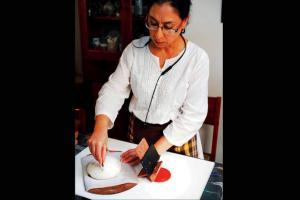Even before sourdough baking became a pandemic trend, a Delhi-based food blogger was winning attention for her wholesome no-knead breads and crackers

Anita Tikoo during a sourdough baking workshop
Back in 2010, when Delhi-based food blogger Anita Tikoo first shared her tryst with sourdough baking on her blog, her comments section, which would otherwise be inundated with feedback, saw zero activity. Tikoo remembers being amused. So much so, that in her next food post, she remarked how her readers had not shown curiosity for sourdough. "Not many people were into baking breads at that time. One of the reasons was the unavailability of reliable yeast in India. What we used to get was a coarse granular yeast with an extremely short shelf-life. It couldn’t have heaved a sigh, let alone raise a loaf of bread," she says. Unmoved by the poor response, she soldiered on. "I wanted to take it to the next level, but at the time there weren’t many resources readily available [on the topic]. The sourdough posts on my blog were also not eliciting much response and so, after about a year of baking loaves and waffles, my first nameless sourdough starter ended its life in a last batch of pancakes," she recalls.
Ten years on, Tikoo has become synonymous with sourdough baking. And, her Instagram handle @a_madteaparty is proof of the community of people she has won over with her breads.
ADVERTISEMENT

Discards from the sourdough starter can also be used to prepare crackers, waffles, pancakes, biscuits, cakes and cheelas
Regular breads that are available in the market use commercial yeast, which consists of a single strain of yeast that helps with quick leavening, allowing the dough to rise in a matter of hours. "But, with speed, the components do not get the time to ferment and break down as they would in slow fermentation, using only natural wild yeast. Commercial bread has poor digestibility, which is why it needs to be fortified with added nutrients and artificial flavours. To give you a soft crumb, it relies on added sugar, food stabilisers and other chemicals," says Tikoo. Sourdough breads, on the other hand, use a sourdough starter, which relies on wild yeast and bacteria to ferment the dough. "It’s a natural and slower process. As the microorganisms break down starches and sugars in the dough, they create new compounds, with more complex flavours." Though the bread is easy to make—all you need is flour, water, and salt—letting it ferment naturally means that the process cannot be rushed. "The quickest you can get a good loaf of bread [from mixing the dough to baking the loaf] is 12 hours. I usually do an overnight refrigerated retard to build additional flavour, which means 24 hours from flour to loaf," says Tikoo, who has been blogging for 13 years.
Tikoo’s second journey with sourdough baking began in 2016. A visiting/adjunct professor at the School of Planning and Architecture (SPA), Delhi, at the time, she began feeling "disenchanted with the teaching and learning scenario". "I was not enjoying it, because students weren’t interested in learning; they just wanted a degree. Teaching graduate students was no longer challenging or as rewarding as it had once been. So, I started taking weekend workshops."

Anita Tikoo
Somewhere around the same time, a journalist friend who had moved back to the UK, set about her sourdough starter and shared a picture of it. "I took that picture on my feed as a sign to get back to sourdough. I have never looked back since," she shares. By then, Tikoo was already teaching yeast-based breads at her workshops. "But I took my time to introduce sourdough bread. I had to first teach myself. So, I kept practising, making the same loaf over and over, week after week, for over a year."
The food blogger has been conducting regular sourdough workshops for home-bakers for around a year. The sessions have moved online since the Coronavirus outbreak. Her love for sourdough breads has reached a point, where she cannot eat any other kind of bread, and for good reason. "Sourdough bread is tastier and more digestible. It doesn’t cause bloating that many people experience on eating commercial bread. It is more nutritious because the slow fermentation makes nutrients available in a form that is readily absorbed by our body. It is a low glycemic food and does not cause the blood sugars to spike," she says. Not to mention it is delicious. "You can use any flour [to bake sourdough breads] or a blend, including ragi and barley. I don’t usually bake with speciality bread flours. I am quite a lazy baker that way, I prefer using ingredients that I can just step out and buy from my friendly neighbourhood grocer," says Tikoo.
For those starting out with sourdough, she recommends restricting whole grains to 20-30 per cent of the total flour, with the rest being maida, to get loaves that balance nutrition with a light crumb. "I tell people not to feel too guilty about the maida because, at the end of the day, you are replacing something that is full of chemicals and preservatives with something you made yourself, using minimally processed ingredients. Be proud of your loaf." She adds, "Over time, with practise, you can increase the whole grain percentage of your loaf to 50 per cent or higher. You can even bake a 100 per cent whole wheat loaf, just know that it will be denser than what you are used to."
Tikoo says that increasing the amount of whole grains in the bread gradually, will allow you to transition from the unnaturally soft bread that one is used to, to a healthier and more flavourful one. "If you suddenly replace a super tender, soft loaf with a dense loaf of bread, it will be difficult to make the switch. As you get more skilled and develop your baker’s hands, you will obtain lighter loaves despite reducing or entirely eliminating the use of refined flour." Discards from the sourdough starter can also be used to prepare crackers, waffles, pancakes, biscuits, cakes and cheelas.
She admits that post lockdown, she has started getting more enquires for her workshops. Even world over, there has been a renewed interest in it, especially with supermarkets running out of fresh bread and yeast stocks. Business magazine Forbes reported how ‘making sourdough starter from scratch’ became the new Instagram pastime, during the pandemic. Currently, there are nearly four lakh posts dedicated to sourdough breads on the photo-sharing app. "I think we have been given an opportunity to be mindful of things around us, including what we are doing to the environment in our pursuit of a supposedly better life. What is unfolding around us is a direct consequence of how we eat and how we interact with the environment and that, perhaps, has made us pause and take a hard and critical look at what we are putting on our plates," Tikoo.
For workshop details, Email mailmadteaparty@gmail.com
Making sourdough starter from scratch

Sourdough breads, says Tikoo, are tastier, more digestible, and nutritious because the slow fermentation makes nutrients available in a form that is more readily absorbed by our body. Pics courtesy/Anita Tikoo
Ingredients
500-750 ml capacity wide mouth glass jar with lid
Whole wheat flour (atta)
Filtered water
A tsp of gud (jaggery), preferably organic (optional)
A cup to measure flour
A spoon to mix
Method
Day 1 /// Morning: Take 1/2 cup of water in a glass jar. Add jaggery and 1/2 cup of atta. Give it a good mix—it should look like a thick paste. Close the lid of the jar and leave on your kitchen counter for 24 hours.
Day 2 /// Feed the starter: Remove (discard) half the contents of the jar. This is your discard*. Add in 1/4 cup each of water and flour. [*You can use the discard to cook with—knead it into a dough for rotis or use in pancakes.]
Day 3 /// Watch the jar for activity. By day three you may see bubbles resulting from the fermentation underway.
Morning: Feed the starter.
The starter will rise steadily and then start to fall. The magic is starting to happen. The starter rises as the yeast multiply and breakdown the sugars in the flour and give off gases as a by-product.
Night: Repeat feed if you see a lot of bubbles. Otherwise, wait till morning.
Day 4 onwards /// From Day 4, you will notice a lot of bubbles and increased starter activity. Continue refreshing your starter at 12-hour intervals till the starter begins to double in 4-6 hours. This can take between 6 to 12 days depending on ambient temperature. In warmer weather (not hot), the starter will stabilise earlier than in colder weather.
For bread and discard recipes >> madteaparty.wordpress.com

Things to keep in mind
. Whole wheat atta will work better than maida for initial feeds, but you may use either or a 50-50 blend of the two.
. Hot climate hastens the process. Under hot conditions, it is advisable to refrigerate the starter during the day and allow it to rise in the relatively cooler nights after a feed.
. Your starter may exhibit a surge of activity on the very first or second day only to appear dead the next. Continue with the feeding schedule as described and it will come back as desirable yeast and bacteria will begin to multiply, while the undesirable ones die off in the now acidic starter.
. Missing a feed will not kill it.
. Every feed involves removing half the mix and supplementing with fresh flour and water. If you are not prepared to throw ‘edible’ food, be prepared for fresh cooked breakfast daily using this leftover slightly-sour starter.
. As your starter matures, you can refresh it using smaller quantities of starter. The ratio is determined by how fast fermentation is going under prevailing climatic conditions (summer or winter) and how long the starter will be left to ferment. The most popular ratio is 1:2:2, one-part starter culture to two parts flour and two parts water (by weight). This is also referred to as a 100 per cent hydration starter (flour and water in the same proportion). In warmer weather or if left overnight, the ratio will need adjusting. For example, for an overnight feed in summer, you may need to feed the starter at a ratio of 1:6:6. Typically, take a very small amount of starter, 5 or 10 gm only, and feed it equal amounts of flour and water.
. Once the starter has stabilised (rises and falls at a predictable rate), you may choose to feed it just once a week and refrigerate between feeds. It can now be used to build a leaven to bake bread with. At this point you can change the flour mix for feeding the starter as per your preference.
. You can also create multiple starters with different flavour profiles by using different flour blends, but desist from switching back and forth. Once established, it is a good idea to feed your starter the same flour blend.
Catch up on all the latest Mumbai news, crime news, current affairs, and a complete guide from food to things to do and events across Mumbai. Also download the new mid-day Android and iOS apps to get latest updates.
Mid-Day is now on Telegram. Click here to join our channel (@middayinfomedialtd) and stay updated with the latest news
 Subscribe today by clicking the link and stay updated with the latest news!" Click here!
Subscribe today by clicking the link and stay updated with the latest news!" Click here!







